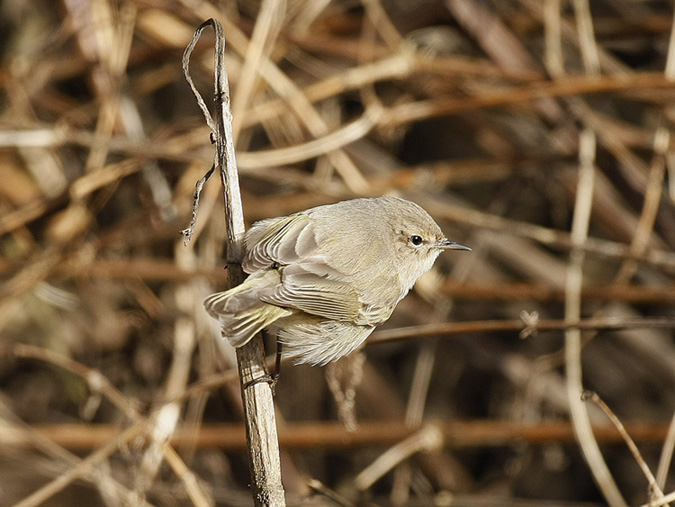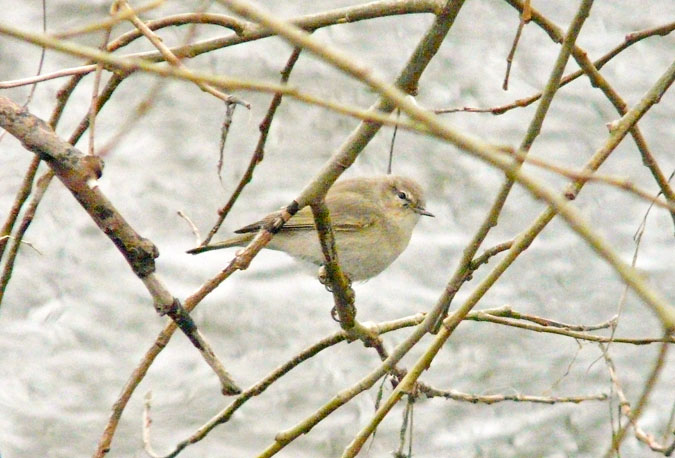A case study from Warwickshire, January 2013 |

© Dave Hutton
Plate 1
The WMBC reserve at Ladywalk, in North Warwickshire, has proved to be one of the more regular sites to host Siberian Chiffchaffs in the West Midlands region (see http://www.deanar.org.uk/general/articles/ybw-wmidlands.htm). Plate 1 shows one of three individuals present in January 2013 and was photographed by Dave Hutton. This photo is strongly lit, which can reduce colour depth, but still captures the 'tan-brown and buff' hues characteristic of tristis. Note the visible texture across the scapulars and wing-coverts and the subtle colour gradations between different feather tracts.
On January 1st 2013, Kay Donaghy, Ian Whitehouse and Martyn Yapp observed and heard 'a pale Chiffchaff with a Bullfinch-like call' at Ladywalk NR, in northern Warwickshire. They considered that it was tristis but, as views were brief, it was cautiously reported on newslines as a 'probable Siberian Chiffchaff'. Subsequently, three Chiffchaffs exhibiting characters associated with Siberian Chiffchaffs were located in the area. They fed in ground vegetation, shrubs and trees but also in vegetation overhanging the banks of the River Tame, and this last habitat provided good feeding even during the heavy snow-falls of the third week of the month. The birds were occasionally elusive but quite regularly provided excellent views as they fed low down in vegetation along the river bank or in shrubbery adjoining the footpath. On some days at least two individuals called frequently, though on other days they could be silent for prolonged periods.
Photographs and sound recordings were obtained and a sonogram was produced from the latter.
In the field, all three exhibited characters associated with Siberian Chiffchaff, such as a lack of evident olive in the crown and mantle and no evident yellow hues on the underparts. Their upperparts were grey-brown and their underparts buffy-white. In the field, there was no yellow visible in their plumage and the only evident olive was on the fringes of the remiges and rectrices. They appeared sometimes a little browner, sometimes a little greyer, according to the prevailing light conditions and the 'background' (for example they appeared greyer and colder when feeding against the grey flag-stones which line part of the river embankment). On dull winter days with low light intensity, the upperparts appeared rather featureless and 'monochrome'. Varying impressions were undoubtedly influenced by genuine differences between the three, with one individual appearing paler and greyer than the other two, but closer and adequately prolonged observations of two individuals together, in more advantageous light conditions, revealed a warmer buff suffusion across the breast, along the flanks and on the vent (plates 2 & 3). Subsequently, high-resolution photographs by Dave Hutton revealed some slight olive streaks in the scapulars of at least one individual (plate 1). Intriguingly, part way through January one individual was noted to be carrying a ring on its right leg. Subsequently, it emerged that it had been trapped and ringed locally but, unfortunately, it had not been diagnosed to taxon level.

© A. R. Dean
Plate 2
In at least two individuals, a warmer 'tan' brown tinge to upperparts and a
sandy-buff buff suffusion on underparts was evident.

Plate 3
© A. R. Dean
The only truly white areas were on the central belly and under-tail-coverts, which contrasted with a warmer buff wash across the breast, along the flanks and on the vent.
Call variations
In the field all calls sounded like short, evenly-pitched monosyllables ('eeep' or 'iiihp') with a somewhat plaintive quality, thus matching Siberian Chiffchaff. The calls resembled one call of Dunnock or a straighter, higher-pitched and less fluted version of a Bullfinch call. Several recordings of calls were made on January 24th 2013. Generally it was not possible to determine which of the three individuals was involved. However, analysis of the recordings confirmed that all calls fell within the compass of currently recognised tristis calls but did include less typical variants. A series of calls can be heard here ►.
There are six calls in this sequence, at 1.7s, 8.5s (very quiet and easily missed), 10.7s, 15.7s, 20.4s and 25.7s. The calls at 1.7s and at 10.7s have been extracted and transferred adjacently to a new file here. Each call is very short (around 0.2s) and will sound very similar to most people. Those with a very good ear may detect that the first call has a 'straighter' (more even) pitch, matching the classic tristis profile, while the second has a slightly more arched, weakly inflected profile. Calls with a slightly arched profile (shallow 'sweeoo' calls) have been recorded from Siberian Chiffchaffs in western Siberia and on the wintering grounds in India (some more distinctly arched and 'disyllabic' than the second call of one of the Ladywalk birds).
A sonogram of the two calls from the Ladywalk bird(s) is below. See the Main Text for discussion and further illustrations of call variants, including the similarities and distinctions of arched 'sweeoo' variants given by various Chiffchaff taxa.

Figure 1. Two variant calls given by Siberian Chiffchaff, Warks, January 2013.
|
|